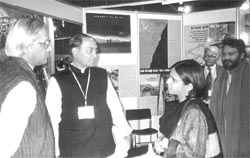Water and common sense
Water and common sense

The New Delhi-based Centre for Science and Environment (CSE) was the only non-governmental organisation (NGO) from the South to participate independently in the World Water Fair, held simultaneously with the World Water Forum. CSE was also the only Southern NGO to hold a full-day workshop. Not surprisingly, CSE's was the only voice that downplayed water scarcity and crisis mongering that is quite typical of global environmental fora. "Make water everybody's business,' the slogan of CSE's campaign for community-based water management, was legally adopted by the organisers.
However, this slogan was misinterpreted, raising a fear: that the private sector would be invited to reach water to the millions in the world as governments had failed to deliver. The private sector thus came prepared with their usual technology offerings.Technologies on how to make water from sewage, how to transport large volumes of water (for the benefit of future water exporters), how to tame and manage rivers, as well as sundry other mega ideas.
CSE went against the tide. The centre had taken a few water managers from India to explain to the world how to water was conserve, manage and share water in an equitable manner without any large investments. With only meagre rainfall and a lot of help from communities. CSE's stall at the World Water Fair drew large crowds. Initial visitors came back to the stall, this time bringing their friends along. Klaus Koenig, a German architect and a member of FBR, a German NGO that promotes ecological housing, was surprised at some of he traditional Indian efforts at water harvesting: "Clearly, we in the West have a lot to learn on how to manage with minimal water."
The exhibition used large, visually attractive panels to describe the millennia-old Indian systems of efficient and equitable water management.
The panels showed positive stories from India. The experiences of the people-centred watershed development mission in Jhabua district of Madhya Pradesh and the efforts of chief minister Digvijay Singh. The "hydrological miracle" of reviving the Arvari river in Alwar district of Rajasthan, a result of the toil of the villages of the region and the motivation and support provided to them by the grassroots agency Tarun Bharat Sangh (TBS). The panels also showed the wisdom of India's rural engineers, who even today manage water locally and keep conflicts over water at bay. There were continuous video screenings on large monitors about traditional water management in India. The centrepiece of the CSE stall was a scale-model of a kundi, a dome-shaped covered well that stores harvested rainwater in several districts of Rajasthan.
A monograph entitled emory of Waterhich was distributed at the stall, created a lot of flutter, as did the leaflet that announced that "there is no water scarcity". A highlight of the workshop was the screening of CSE's film Arvari: a twentieth century folk tale. The film documents the revival of the river Arvari and how it became perennial. The issues that were discussed included the role of science, bureaucracy and donors.
CSE also organised a one-day workshop on lessons in community-based water management. The aim was to show that water shortage in many parts of the world is a result of mismanagement. The session included exemplary case studies from rural and urban area as well as the policy requirements to promote community-based water management. Describing their experiences in this field were people who have managed water by harvesting the rains. Speakers included social reformer Anna Hazare of Ralegan Siddhi in Maharashtra and Rajendra Singh of TBS.
Digvijay Singh inaugurated the workshop. He stressed the need of harnessing the power of the people to meet challenges of ecology and economy. Sunita Narain, CSE's deputy director, said that community-based water and environment management was a tool for poverty alleviation. She underlined the need for evolving participatory democratic systems so that communities had rights over their natural resources.
The message was clear: the answer to meeting water demand lay not with the government or with private corporations. The answer lies with communities and their democratic empowerment, and that this "alternative" water management must turn into mainstream water management.







